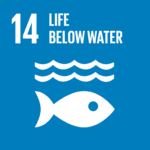A series of whale strandings has captured the attention of marine experts in Indonesia, with three giant mammals beached on Bali’s shores since the start of April.
The first sighting was a decaying 11-meter-long Bryde’s whale discovered on Bali’s southwest coast on April 1, followed by a live sperm whale measuring 18 meters found stranded on a beach in the southeast, which locals managed to push back out to sea but ultimately died on another beach. The most recent incident over the weekend involved the discovery of a 17-meter-long sperm whale – an unusual occurrence for the deep-sea species.
RELEVANT SUSTAINABLE GOALS


Marine Plastic Pollutions and Ocean Heat as Potential Causes
These events are part of a larger phenomenon that has seen 21 unexplained whale strandings across Indonesia since the beginning of the year, according to the Ministry of Fisheries and Marine Affairs. While post-mortem examinations are being conducted on samples from two of the three whales found on Bali’s shores, the results may not provide a definitive answer for the spate of incidents.
Some wildlife campaigners believe that plastic pollution is to blame for the unusual number of strandings. Indonesia is the world’s second-largest source of marine plastic pollution, with plastics found in the stomachs of whales and other marine creatures. “Plastic pollution, when plastic is found inside whale stomachs, and noise pollution, when sonar the whales use for navigation is harmed by underwater noise and they get confused and beach themselves, are two of the leading causes of death,” said Femke den Haas, a wildlife paramedic and co-founder of the Jakarta Animal Network.
Permana Yudiarso, the head of the Bali office for coastal resource management at the Ministry of Fisheries and Marine Affairs, has said that the recent strandings on the island are abnormal. “Last year, we had nine incidents in Indonesia. Normally we have less than 20 every year. But three cases in a week only in Bali – it’s quite concerning,” Yudiarso said. “We are in the middle of that period now. It could be related to the tropical storm we had in Java last month or a more recent storm north of Australia in the Timor Sea. We also can’t rule out the effects of underwater earthquakes – we have them all the time in Bali. On Monday morning, there were two earthquakes and that might have disturbed the whales’ sonar.”
As marine experts and wildlife campaigners continue to search for answers, the concern remains high that plastic pollution and other environmental factors may be causing harm to marine life in Indonesia’s waters.
Oceans Are Getting Hotter
In 2019, a groundbreaking study published in the scientific journal, Nature Climate Change, sounded an alarm on the dire state of our oceans. The study revealed that the warming of our oceans was causing extinction risks to soar, and marine biodiversity to plummet. It identified several regions across the Pacific, Atlantic, and Indian Oceans as being highly vulnerable to intensifying marine heatwaves, which put marine life at risk. Shockingly, Indonesia emerged as one of the five worst-affected areas.
Fast forward to 2022, and the situation has only worsened. Ocean heat has hit a record high, leaving marine life struggling to cope with rising temperatures. Karen Stockin, a professor of marine biology at Massey University in New Zealand, emphasizes that we need to distinguish between climate change and regular marine heatwaves. While both can disrupt the distribution of prey such as squid, which can lead to the predators like whales that depend on them, changing their distribution, they are not the same.
According to Stockin, “If changes in distribution bring whales closer to shore, that can potentially increase their risk of stranding.” This makes it all the more urgent to take decisive action to address the warming of our oceans, to protect the marine life that depends on them, and to secure the future of our planet.
You may also be interested in :
Samsudin Dongeng Keliling: Inspiring Environmental Awareness Through Fairtales



